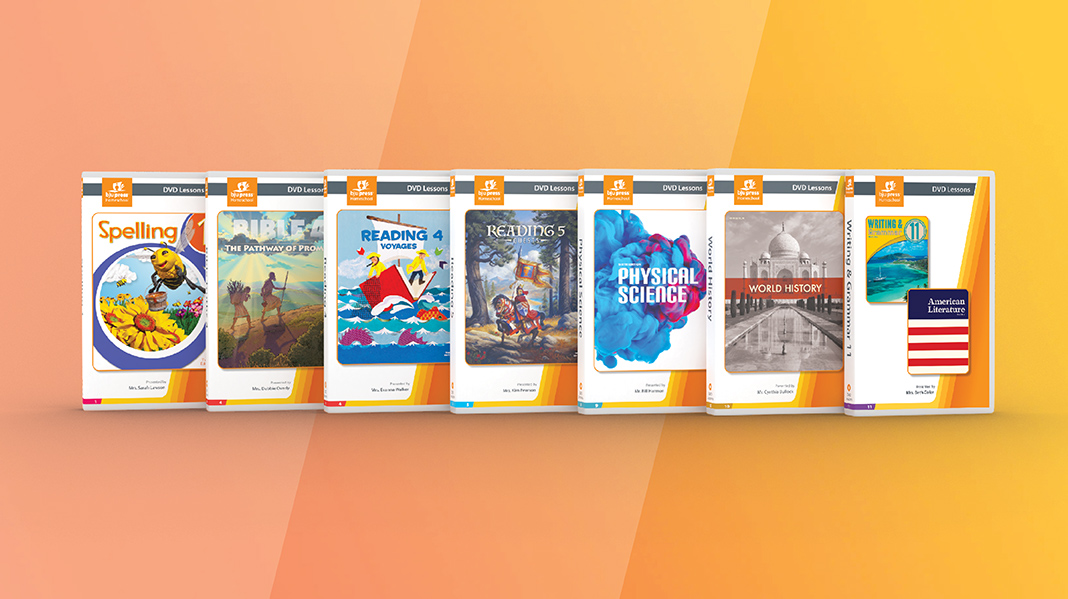
We are excited to introduce our new video courses for 2021! This year we have seven new courses that span from Grades 1–11. Each course is age-appropriate and, above all, is designed to excite a love of learning in your students. For more information about these new courses, see our new 2021 Catalog! [Read more…] about New Homeschool Video Courses
homeschool curriculum
Homeschool Curriculum: Going Beyond the Books
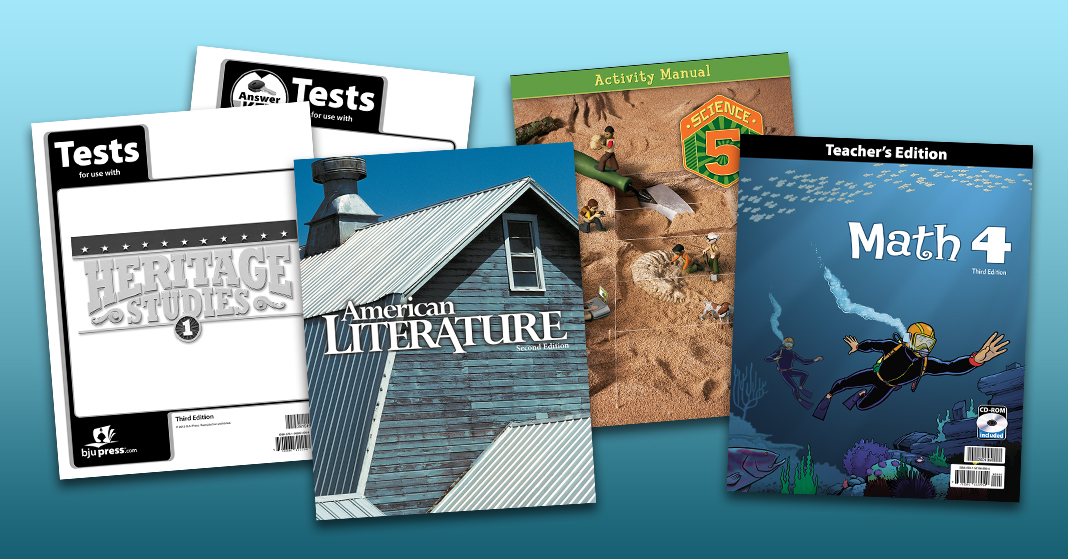
What are all these books even for?
Have you ever caught yourself thinking that as you unpack your boxes full of homeschool curriculum for the year? Especially if you’re teaching the material yourself, there’s a lot of stuff in those boxes. Mixed in with the excitement for the coming homeschool year, you might find yourself asking, “Do I really need all this? What do these books do?”
Teacher Edition
If you really want to teach your children yourself, you need something that’s more than a glorified answer key. A good teacher edition will give you valuable resources that equip you to teach each lesson in a way that enables your children to understand the content.
You don’t have to be a subject expert to teach your children. And, as a parent, you’re probably already an expert or becoming an expert on how your children learn. What you need in your homeschool curriculum is a resource that equips you to create a learning experience that your child needs—without long, fruitless Pinterest searches.
BJU Press teacher editions offer strategies for presenting the content in ways that will bring children into the lesson. Those strategies may use hands-on learning, visual learning, discussions, or even storytelling. For example, you don’t have to go find resources for your study of light in Science 4. The Science 4 teacher edition offers additional resources for you, including directions for creating a shadow box theater or a kaleidoscope.
To get your children really thinking about what they’re reading, you need to ask questions. But what kind of questions? Which ones will get your kids really thinking about the content? Discussion questions and worldview development strands that you can choose from get your children thinking about the content. Additionally, they help them know how to think about it from a biblical worldview.
Besides teaching strategies and discussion questions, teacher editions also include lesson guides, background information, rubrics, answers, lesson plan overviews, and suggested schedules for the year. A teacher edition is truly a teaching resource.
Student Edition
The student edition or student worktext will be the most familiar piece. You might think of it as the core of your homeschool curriculum. It’s the book your children go to every day—or most days, depending on your schedule—to read lessons and complete assignments. Some textbooks may give you flashbacks to your high school days or make your homeschool feel like you’re just doing “school at home,” but a good textbook goes beyond the stereotype.
Textbook material will often be the first informational texts that your children read. Reading informational texts is an important skill for kids to develop because they will be reading and interacting with informational texts throughout their school days and as adults. When was the last time you read an instruction booklet, a news blog, or a how-to article? What about a devotional book or a sermon transcript? Even this post is an informational text. Information is all around us, and children need to learn how to read it, think about it, and respond to it appropriately. That’s why every BJU Press textbook is designed to help students as they work with informational texts.
Activities
An activities book seems kind of self-explanatory, doesn’t it? It’s a book full of activities. But what do those activities do? Many of them will be simple exercises that require just the book and a pen or pencil. Even though these activities seem simple, they give your kids a chance to review what they’ve learned so that they can develop mastery with the content. Other activities, especially in science, will be important for approaching the content in a different way. Not all children learn the same way, and your children may need to receive different kinds of information in different ways. So BJU Press activities also give your children the opportunity to draw pictures or diagrams of the content, to create models of it, to act it out, and so forth.
Assessments
Tests may be the bane of most students’ existence, but they do serve the vital function of giving you a way to evaluate whether your children are learning the skills they’re supposed to be learning. You may not plan on keeping track of all their scores, especially if you don’t have to submit grades to your state or a homeschool organization. But even if you don’t use the grades—because the numbers don’t really matter anyway—you can still use the information. Are your children showing that they can comprehend what they’re reading? Are they able to use reasoning skills as they answer questions? Can they think critically about the information? Are they drawing valid conclusions about it? Your children aren’t so much acing or failing tests as they are showing successes or weaknesses in their learning.
Do you know what all these homeschool curriculum pieces have in common? They’re all designed to do exactly the thing you want to do in your homeschool—teach. They give you manageable lessons so that you don’t have to go looking for lessons or create your own. Learn more about our textbook kits to find the perfect fit for your family!
Introducing Our Third Grade Homeschool Curriculum
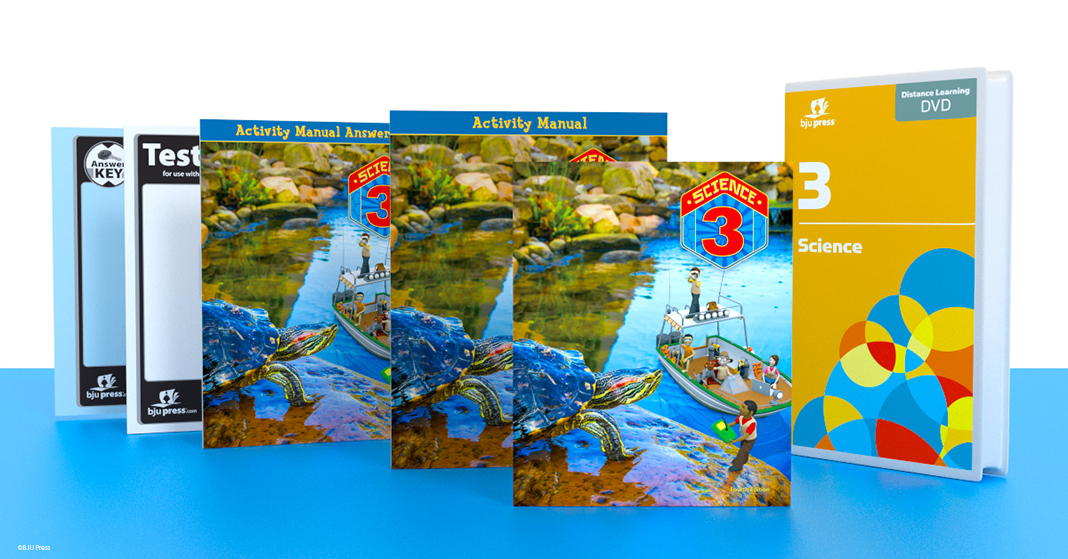
My family likes to remind me about how, as a homeschooled child, I used to sit on the porch and wait for my textbooks to be delivered. I would get so excited about opening each box, unpacking all the materials, and flipping through the books to see what I was going to learn about during the homeschool year.
This year, I got that same thrill when I unpacked my daughter’s third-grade BJU Press curriculum. You can watch the YouTube video of my husband and me unpacking our boxes, but I wanted to hit a few of the highlights.
It’s a lot of stuff.
We ordered three textbook subject kits (Math 3, Spelling 3, and Reading 3), one stand-alone workbook (Handwriting 3), three Distance Learning subject kits (English 3, Bible 3, and a combination Science/Heritage Studies 3 kit), and a stand-alone Teacher’s Edition (Heritage Studies 3). By the time everything is delivered, we will end up with eight boxes (six are shown in this video). We actually stacked the boxes up against the wall, and the tower was taller than my rising third grader. It’s a lot of stuff, but since this is our second year using BJU Press materials, I didn’t find it as overwhelming as I did last year. I know that everything has its purpose. Now I just need to get it all organized.
I can hardly wait to begin.
Our homeschool year won’t start until the beginning of August, but I’ve found myself unable to resist looking through my boxes of curriculum. I have even begun reading some of the teacher’s editions.
I think I am most excited about the fourth edition of Science 3, which is a brand-new Distance Learning course taught by Mrs. Overly. My daughter had Mrs. Overly for Science 2 (4th edition) and English 2 (2nd edition) last year and absolutely loved her, so I know the video lesson content is going to be awesome. But the textbook content is what really impressed me. The textbook authors have done a phenomenal job developing critical thinking and biblical worldview skills. For example, on page 114 of the Student Activity Manual, students are asked to “describe the forces that affect how you move a wheelbarrow. Then explain how you can use what you know about these forces to help you work better.” The manual is full of questions like this that will really make my daughter think.
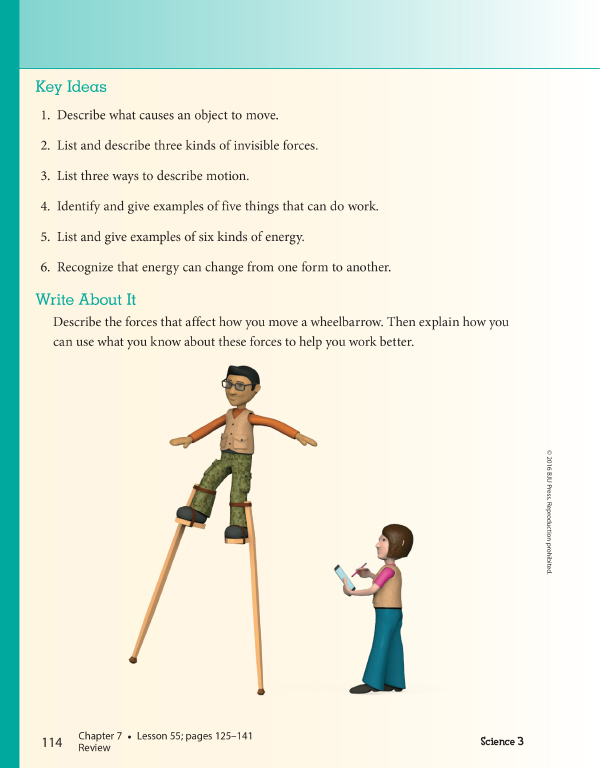
I could probably write an entire post about how much I love my BJU Press third-grade curriculum, and I’m sure that I will be highlighting some of my favorite features in future posts. If you want to learn more about our Distance Learning courses, you can watch sample video lessons for each subject on YouTube. You can also check out last year’s unboxing video if you want to know what we used for second grade.
I’m curious—have you unboxed your homeschool curriculum yet? What are you most excited about? I’d love to hear about it!
3 Things My Homeschool Curriculum Can’t Do
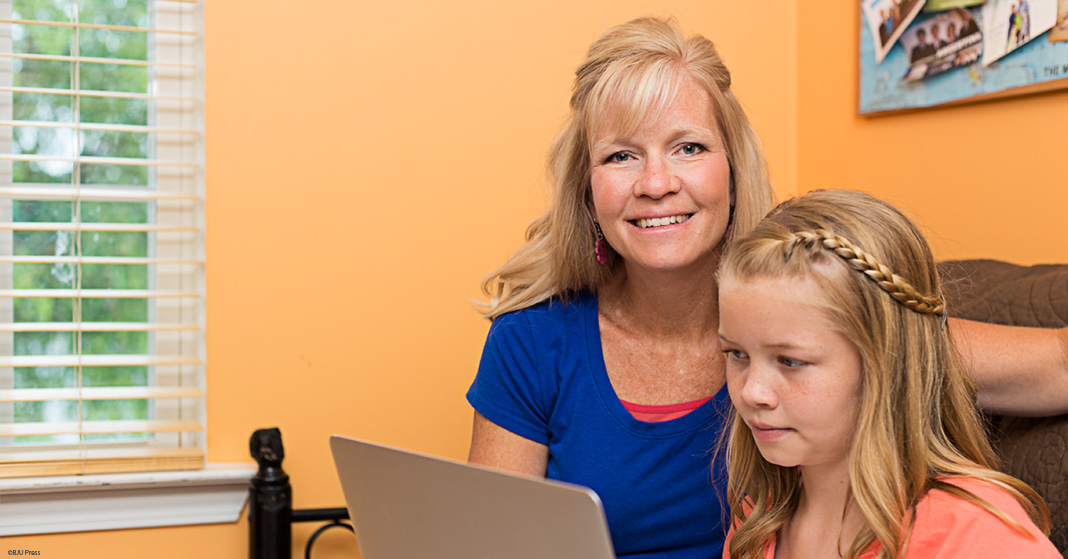
Walking into the exhibit hall at a homeschool convention can be an overwhelming experience. There are so many booths! Just like at a bazaar, you can buy fresh food, legal advice, blankets, oddities, and toys. At one convention, I picked up some hair styling devices for my daughters.
And then there are the curriculum providers. The options seem endless. There are Charlotte Mason materials, literature- based programs, and traditional curriculums. At some conventions, you’ll find more than a half dozen providers of classical homeschooling curriculum alone. With so many options how do you choose?
A curriculum helps you package content, create learning experiences, and stay on track. It can do quite a bit to make homeschooling successful. But as much as a curriculum can do, it can’t make my child learn. Learning is what happens inside of my child. Curriculum provides information that is outside my child.
When it comes to how to choose a homeschool curriculum, I think it is important to consider what a curriculum can’t do.
1. No homeschool curriculum can love my child as an individual.
Everyone creating homeschooling curriculum loves children. But they can’t love my child as a unique person. Only my wife and I can do that.
Children need to know that the person teaching them loves and wants what is best for them. Education requires a lot of work on my daughter’s part. For my child to learn and grow, she must have the assurance that her effort is worthwhile. If she suspects that the person providing the information and teaching the skills doesn’t care about her well-being, she won’t internalize the content.
Individualized love is what makes classroom teaching so challenging. A classroom teacher must establish a relationship of trust with each child in a group of twenty or thirty students. And the teacher must do that every single year. A loving home provides that individualized love naturally.
2. No homeschool curriculum can create accountability for learning.
Since learning happens on the inside, we can’t just put educational content around a child and expect learning to take place. I’ve seen this failure several times with my daughter. We handed her an assigned reading or exercise, and she went through the motions without engaging her mind in the learning. As a result, the information just poured through her head like water into a bucket with a hole in the bottom.
Children need to know that their parents care enough about them to ensure they’ve got it. Whenever our daughter becomes lackadaisical in her learning, we correct the attitude and show her that she must internalize the information and skills. She has been quick to respond, not only taking responsibility for her learning but also enjoying it.
3. No homeschool curriculum can challenge my child to do his or her personal best.
Each child is different. Sometimes a child misses every fourth question on chemistry tests, but you know he’s doing his best. Other times, you can tell your child is getting a hundred percent of the questions right but isn’t doing his best.
There was a time when my wife and I saw our daughter getting perfect scores in two subjects, but she wasn’t trying her hardest. So we talked to her about it and started writing harder tests. At first she didn’t think it was fair. But by the end of the year, she was excelling and was satisfied that she had done her personal best.
Homeschool curriculum presents information in an engaging way. It gives roadmaps for learning so that children are ready for the next step. Curriculum can also provide activities that develop skills and deep understanding. But it cannot create a nurturing environment in which children know that they’re loved, that the learning is for their benefit, and that they will always be challenged to do their best. Only a parent can provide that environment.
The Bridge of Understanding

Recently, I’ve been thinking about a similarity between my parenting and my homeschooling. In parenting, I’m less concerned about behavior modification than I am about my child’s heart attitude. If a little girl grabs a toy from her sister, I want to change her heart toward her siblings. But behavior merely reflects the heart. When a little one loves her sister, she won’t take toys from her.
The problem is that I can’t see what’s inside my child’s heart. However, I can see her behavior and then try to deal with her heart by questioning her about her behavior.
I think this is similar to education. The goal is understanding, but you can’t see understanding. It’s actually difficult to test for understanding. So how do we know when our children truly understand a concept? If we focus on facts, we’ll get surface level memorization from them. So what can we do?
The Bridge of Understanding
Understanding a topic is the critical step toward mastering more challenging cognitive activities. You cannot evaluate a piece of literature until you understand it. You also can’t apply math until you understand it. On the other side, if you understand who Napoleon was, it’s easy to analyze him. If you understand paragraph writing, you’re ready to create one.
So if your children can handle projects and test questions that require higher-order thinking skills, you know that they have moved beyond recall and now understand the topic. Here are four types of higher-order thinking that you can check for to see if your child understands a topic.
Apply
When we take a subject and use it in another context, we’re applying. Math, science, and grammar are easy to apply in everyday activities. Have your child use math concepts to plan snacks for a group. You might explain that each batch of cookies makes twenty-four and we’re expecting thirty guests. How many batches should we make?
Analyze
Analysis sounds scary, but at the most basic level you’re just breaking a subject down into its parts and explaining their connections. In history or reading, small children can do analysis by making word webs. Meredith has an excellent post on word webs that can be applied to any subject.
Evaluate
Evaluation involves comparing something to a standard. Christians evaluate all academic subjects according to God’s Word. We also evaluate a writing sample against grammar rules and science hypotheses against observations. When children can use a standard to make a judgement, they understand their topic.
Create
Creating is a type of thinking that rewards children by allowing them to use the subject in a creative way. I was so proud of my second grader when she wrote a poem on kites after learning about poetry. It was better than any poetry I’d ever written. When students use principles from science, technology, engineering, and mathematics to solve a problem, they’re creating in a satisfying way that conforms to the way God made us to function.
It’s hard to measure a child’s understanding of a topic. But understanding is a bridge that connects other activities such as applying, analyzing, evaluating, and creating. If we focus their learning on these higher-order thinking skills, we can be confident that our children have gained understanding. BJU Press homeschool curriculum builds bridges of understanding for children by having them apply, analyze, evaluate, and create.
Why choose BJU Press homeschool curriculum? Find out here.